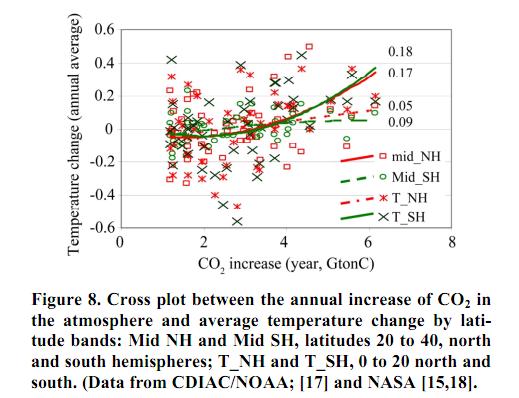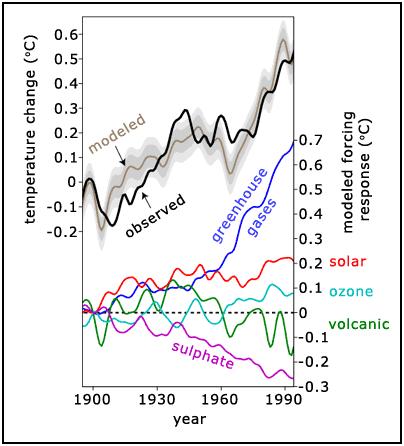
What The Science Says:
Soares looks at short-term trends which are swamped by natural variations. Increasing CO2 causes a gradual long-term warming trend which is smaller than the short-term variations. The long-term correlation between CO2 and temperature is well established.
Climate Myth: Soares finds lack of correlation between CO2 and temperature
"The comparison of temperature changes and CO2 changes in the atmosphere is made for a large diversity of conditions, with the same data used to model climate changes. Correlation of historical series of data is the main approach. CO2 changes are closely related to temperature. Warmer seasons or triennial phases are followed by an atmosphere that is rich in CO2, reflecting the gas solving or exsolving from water, and not photosynthesis activity. Interannual correlations between the variables are good. A weak dominance of temperature changes precedence, relative to CO2 changes, indicate that the main effect is the CO2 increase in the atmosphere due to temperature rising. Decreasing temperature is not followed by CO2 decrease, which indicates a different route for the CO2 capture by the oceans, not by gas re-absorption. Monthly changes have no correspondence as would be expected if the warming was an important absorption-radiation effect of the CO2 increase. The anthropogenic wasting of fossil fuel CO2 to the atmosphere shows no relation with the temperature changes even in an annual basis. The absence of immediate relation between CO2 and temperature is evidence that rising its mix ratio in the atmosphere will not imply more absorption and time residence of energy over the Earth surface." (Paulo Soares)
A recent paper in an obscure journal (Soares, 2010) used correlations between temperatures and CO2 concentrations to conclude that;
"The absence of immediate relation between CO2 and temperature is evidence that rising its mix ratio in the atmosphere will not imply more absorption and time residence of energy over the Earth surface. This is explained because band absorption is nearly all done with historic CO2 values."
Soares looks at correlations between change in CO2 and change in temperature for a month to a few years. He doesn't find a correlation between short term CO2 changes and temperature changes in the following months. His Figure 8 shows the change in temperature or CO2 from one year to the next.

Do we live in Soares’ world where CO2 isn’t causing warming, or in the world of mainstream physics where theory and measurements show increased CO2 heating? What does mainstream physics expect to see in the above graph?
Firstly it expects atmospheric temperatures to change regularly: natural cycles like El Nino transfer heat from the oceans and can change atmospheric temperature by up to 0.4 °C in a year causing the big vertical spread.
The graph below is based on Meehl et al, 2004 and shows a climate model estimate of how much global warming was expected from greenhouse gases for the past century: always less than 0.02 °C/year - so small that the noise effectively hides the incline if you only look at year to year changes. Fortunately, very simple statistical techniques work around this.
Some rough calculations using the NASA global data shows that to detect the expected CO2 global warming for the past 40 years at 95% confidence would require about 160 years of measurements - and hundreds more measurements to detect the CO2 signal when it is smaller.

We have some more expectations for the graph: low CO2 emissions should mean slow warming and vice versa. On the left of the graph we expect average warming of under 0.01 °C/yr and on the right hand side we expect just under 0.02 °C/yr. So if you plot a slope you expect it to be positive – going from 0.01 on the left up to 0.02 on the right but practically impossible to find amongst so much noise (although Soares does plot it).
The next trick is to implicitly assume that nothing else shows a warming or cooling pattern: but we know that there is. From the 1940s to the 1970s we pumped enough reflective aerosols into the atmosphere to temporarily halt global warming by 'global dimming' (Ramanathan et al, 2001).
This is like putting a pan of water over a lit gas stove and then dropping in an icepack big enough to cool the water. Soares would say the cooling shows that burning gas can’t heat water, but mainstream science says that a big pack of ice temporarily masks the heating and that burning gas does, in fact, make water warmer than it would otherwise be. Importantly, you can account for the ice and determine whether the heat is on and other scientists would do this.
Soares’ method is like searching for a needle in a huge haystack by picking a handful of hay rather than using a magnet. You almost certainly wouldn’t find the needle even if it was there, so to claim you’ve disproved its existence when other scientists have found it with their magnets is simply stunning.
 |
The Skeptical Science website by Skeptical Science is licensed under a Creative Commons Attribution 3.0 Unported License. |